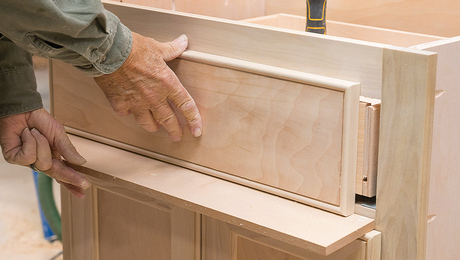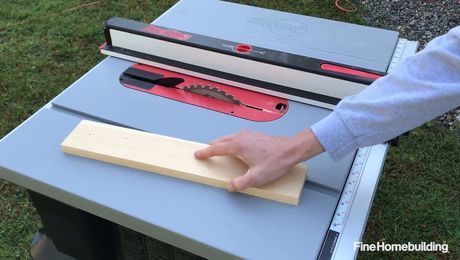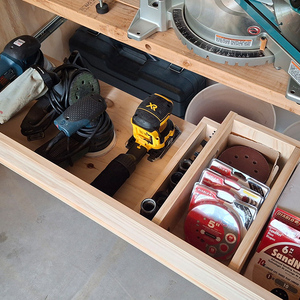I love these things, anybody else use them? $16. per 100. Never going to use the Nuts again.
Discussion Forum
Discussion Forum
Up Next
Video Shorts
Featured Story

From building boxes and fitting face frames to installing doors and drawers, these techniques could be used for lots of cabinet projects.
Featured Video
SawStop's Portable Tablesaw is Bigger and Better Than BeforeHighlights
"I have learned so much thanks to the searchable articles on the FHB website. I can confidently say that I expect to be a life-long subscriber." - M.K.
Fine Homebuilding Magazine
- Home Group
- Antique Trader
- Arts & Crafts Homes
- Bank Note Reporter
- Cabin Life
- Cuisine at Home
- Fine Gardening
- Fine Woodworking
- Green Building Advisor
- Garden Gate
- Horticulture
- Keep Craft Alive
- Log Home Living
- Military Trader/Vehicles
- Numismatic News
- Numismaster
- Old Cars Weekly
- Old House Journal
- Period Homes
- Popular Woodworking
- Script
- ShopNotes
- Sports Collectors Digest
- Threads
- Timber Home Living
- Traditional Building
- Woodsmith
- World Coin News
- Writer's Digest




















Replies
was coming to post just the same question.
saw our sparky using them the other day and was wondering what other sparkies thought of them... reminds me a little to much of the push in slots on the back of a receptacle...
as a side note... my puppy is "nut-less" as of about 6 hours ago, he looks genuinely pissed at me, and won't let me approach him.
Installed 30 can lights a few week back, Capri Quick lights I think they were called.
They had the same type of push in wire connectors . Saved a little bit of time with the rough in. Install 4 fans last week & used them again. Sure like them!
Hope your pup does'nt hold a grudge!
Wouldn't you be pissed if someone did that to you?
Dogs are smarter than we give them credit for; he'll find a way to get even- poop somewhere, chew up something, make you chase him around the neighborhood for hours...
Good for fixtures.
Good for situations where the wires in the box are so short, it's impossible to get a wirenut on 'em.
I've taken a close look can see that they're significantly better than the push-in backwire teriminals on a cheap receptacle. In the latter, the connection is a point of contact between the edge of a thin strip of spring bronze. In the Ideal in-sure connectors, the wire is firmly pinched between two flat pieces of spring steel (tin-plated, I think). There's a lot more contact area between the wire and the connector, and the force is a lot greater (and looks to me to stay tight).
Although I think they're a lot beefier connection than the cheesey poke-in back wire receptacle terminals, I don't use them for general-purpose receptacle circuits.
Cliff
There is a guy here in Kansas City that developed article replacements in case the puppy feels self consuses.
Reminds me of a Far Side cartoon ....
Fido is riding in the car with his master, leans out the window to yell to the other dogs in the yard "We're going to obediance school, then I'm going to get tutored!"
I'm sorry, I thought you wanted it done the right way.
Reminds me of a Far Side cartoon ....
Unhuh..
And the wire dealies... A couple smoke detectors I wired in had kinda similar plugs. You wired it to one end of the harness and it plugged into the other. Made it handy to pull the detector down. Easier than having to wire/unwire it to pull it down.
jt8
Nothing so needs reforming as other people's habits. -- Mark Twain
he's afarid of what else you might do...
Life is not a journey to the grave with the intention of arriving safely in a pretty and well preserved body, but rather to skid in broadside, thoroughly used up, totally worn out, and loudly proclaiming
WOW!!! What a Ride!
Forget the primal scream, just ROAR!!!
I warned him not to chew the couch...
next time I'll have the doc move up a little.
U could really piss the poor dog off and go buy one of those stupid "sets" to hand off the back of yer truck!
Jeff
They sell them locally, but I haven't seen any pros using them. I picked up a few a while back but haven't used them yet.
I have used a few that were provided by fixture manufacturers. So far as I know they are still working. That said fixture wire is in a controlled environment and handle a fraction of the load of the circuit.
These units have been on the market for some time, about seven years or so. So far I haven't seen many professional electricians use any of these excluding those provided by the manufacturers.
IMO they are not actually any less bulky and box filling than the nuts they replace. Given the spacing of the conductors inherent in the design I think they take up more room. They also seem less adaptable.
The general design reminds me of the push-ins on cheap receptacles that are used by, IMHO, hacks. This is not encouraging and does not inspire confidence.
At $0.16 each in bulk packs of 100 they are not cheap.
My initial impression, granted it is from my limited perspective, is that they are bulky, limited, use a questionable design and are not significantly cheaper than what they are supposed to replace.
Final analysis is that I will give it additional time for a consensus to form before I buy any but those included in fixtures. Wirenuts are cheap, simple, have a long history of reliability and I have done so many that I can install them pretty much automatically. Wirenuts are pretty strong competition and these units don't obviously seem to offer any advantages.
Given a choice I won't be installing these units, in any major way, any time soon. This, of course, assumes it is not a job requirement. If the architect specs them for a commercial or industrial job and they are supplied in leu of wirenuts I will install them. I will do my best to install them according to manufacturers instructions.
It isn't like I'm going to supply a job with a thousand dollars worth of wirenuts so I can do it my way. Sometimes I get to steer. Sometimes I just paddle. So far the specification writers, architects, electrical engineers haven't thought enough of them to require them in design specs.
Some fixture manufacturers like them and in that roll they may be adequate. Same manufacturers used to supply IDC connectors ten years ago. You can find the same IDC connectors along side these units at teh local Home Despot. Now they supply these. I suspect they got a good deal on them. As they likely did with the IDCs before them. Possibly because they haven't been selling. So it goes.
Edited 4/25/2005 10:52 pm ET by 4LORN1
Seems like they said the same thing about wire nuts when they came out.
DaneI will always be a beginner as I am always learning.
Re: "Seems like they said the same thing about wire nuts when they came out."True enough in the broader context. Construction folks are inherently conservative, in the best possible way. First connections were simply wrapped. A series of splices and taps were used. At first most were not soldered and many not insulated. Inside wiring was, eventually soldered and, some time later as rubber insulation developed, insulated. Along the way, sometimes a regional thing, various connecting devices, were tried. Split-bolts, terminal blocks, crimps and early wirenuts were tried. They all had advantages. Which is why we still see these today.You right that each had critics. Many of these were pretty weak. Most of these methods started out pretty weak and only over time and with experience, much of it gained at considerable cost in property and lives, were improved. Electrical work possibly uniquely among construction trades is potentially dangerous. And a danger that is not obvious. Something as simple as a bad connection can be costly in injury, lives and property damage. Wirenuts have a long history and have developed over a long time into a reliable and well understood product, technology and method. Any product claiming to replace wirenuts, even in limited or narrow applications, have a high standard to meet. There have been some products that tried to compete with wirenuts and most, for the most part, have failed to make the cut in anything but limited situations.That isn't to say that new and improved methods, as long as they are actually improved on most fronts, are not welcome. But anything new is facing stiff competition. It is going to have to prove itself in the real world.
Thanks for the history lesson.
Never know, but I think that there will be a day when the copper wire will be replaced with fiber optic for house wiring. Right now the biggest draw back is expense. It would be a lot safer and more energy efficient though. Does anybody know if there is any experimenting going on in this area at this time?
Just last week I removed the wall between the living room and the kitchen and spanned the opening with a header. Had to move 2 three way switches over to another wall. When I got them open I discovered the old twist and wrap connection that you talked about. The wrap was done with the old friction tap. (fiber tap) When I put them back together on the new wall I used wire nuts. The house was built in 1960. Been taking pictures of it all and hope to have them posted in a couple of days.
I have felt both 110 and 220. The 110 just gave me a little tingle. Made me step back is all. That 220 knocked me on to my back side, from up on a ladder. I was trying to get a reading on my meter when I brushed up against one of the leads. I didn't feel much like sitting down for a few days.
DaneI will always be a beginner as I am always learning.
Replacing house wiring with fiber optic would be more dangerous that the existing wiring. The intensity of light you'd have to send down the fiber to convey that much power would be incredible, and a slight nick in the fiber could result in a blowtorch-like beam of light.It WOULD be nice if some sort of digital control system (kind of X10 on steriods) would come into use. Fiber or low-voltage wiring could be run to the switches (or radio signals could be used), and fixtures could be easily reconfigured to be controlled by different switches. Power distribution would take on more of a bus architecture.
Fiberoptic systems are often used. The fiber is a lot bigger than communications fiber and made out of plastic. The stuff we played with was about 1/2" OD. The lines were run back to a high intensity lamp. Similar to the bulbs used in overhead projectors.In most cases the reason for using this more expensive method is to get a complex lighting setup, with many sources, colors and focus patterns, into an area that has water. The complex illumination jobs used in some high end fountains and pools.Advantage being that the lightguides coming from a central light source won't conduct electricity. The output end is a simple lens system. The central source makes it easy to change the color in a dramatic fashion. A fixed or rotating colored gel is inserted between the lamp and the input into the fiber light guide.This is how the colors are changed in time to the music when fountains are used in performance. It also makes for interesting possibilities for lighting a pool at a home. A lot more adaptable than the typical two or three fixed wet-niche fixtures.On the less frivolous endpossibly one of the most fascinating light sources is the microwave driven sulphur bulb. Extremely efficient in terms of lumens per watt. Near perfect color rendition. Overview is something like this: High purity sulphur is encapsulated in a quartz sphere and this is mounted on a shaft. This is suspended in a metal box and a microwave gun is aimed at the sphere. Microwaves flood the enclosure and raise the energy state of the sulphur which radiates light almost as white as the sun. Feed the microwave emitters something like 100w, I'm going from memory so these figures are only illustrative, and you get more light than 20 - 100w incandescent bulbs. About enough to light a home and far more efficient than florescent lamps.Technical challenges are not insignificant. The central lamp runs in a small range or not at all. Essentially wide open and only wide open. At a very high temperature. So high the quartz sphere has to be spin when the lamp operates or it heats unevenly and stress fractures develop. The central unit is complex, expensive and very hot. THe fixture needs a cooling fan and a flue to exhaust the heat. It isn't like you want a whole lot of these units in a house. Plan is to install one or two of these units in the attic and run lightguides to the fixtures. Liquid crystal light gates or mechanical shutters at the fixture or source control which light get turned on. The fixture would use reflectors or lenses to control how the light is distributed.Advantages are that there are no normal light bulbs to burn out. The fixtures can be made so they are not connected to electricity which makes lighting showers, whirlpools and steam rooms simpler and safer. The heat that would be created in a normal fixture is not present so the fixtures can be sealed and encased in insulation without overheating. Significantly improving the integrity of the building shell. The heat associated with typical fixtures are also inside the insulation shell. This heat you pay for twice. Once to power the light and once to run the AC.While heat recovery systems would be impractical for individual fixtures with the sulphur system the heat source is in one location. The preferred situation for heat recovery. Either to heat the house or, more likely, water.Read more:
http://www.thekrib.com/Lights/sulphur.htmlhttp://eetd.lbl.gov/newsletter/CBS_NL/NL6/S-Lamp.html
For something less exotic and troublesome than sulphur, you could try xenon arc lamps, which are the standard thing for movie theater projectors.
-- J.S.
Presently the light-guide systems presently being installed from off-the-shelf parts, as far as I can tell, are smaller systems that use some sort of projector lamp for the central light source. Of course the sulphur lamp would produce more and better light, CRI, for the same energy but the fiber light guide system is not dependent on it.
> Seems like they said the same thing about wire nuts when they came out.
And what did they say about aluminum wire when it came out?
Wire nuts turned out to be OK, aluminum wire didn't. Which way this new idea goes won't be known for a few years. Personally, I'll let somebody else do the finding out, unless I really fall in love with a new idea enough to take a chance on it. This one doesn't turn me on.
-- J.S.
I have yet to see these things up here, but then we generally lag a bit on 'new product' availability, LOL....
My first comment would be that these gizmos look like they are permanent; which is to say, if I come in 5 years from now to re-wire a box during a remod that adds, say, a can light in a new hallway, I'm looking at cutting and tossing the nutless thingy out of there instead of just untwisting a wirenut and adding in the new branch.
Doesn't sound like a particularly 'good thing' from that point of view....
Dinosaur
'Y-a-tu de la justice dans ce maudit monde?
I just used something like that in Europe wiring my BILs apartment. (You know Spanish apartments come BARE?! No appliances. No FIXTURES! You take them with you when you move.)
I was so taken with them, I bought a mess at a hardware store to smuggle home. Something like 50 cents US for a strip of 12 for 12- or 14-gauge. You break off as many - 2 or 3 or 4 - as you need. Sizes for 6 or 8 gauge weren't much more, maybe $1.50 for 12 terminals. And that was retail one-off pricing.
The insulating tubes that lead to the terminals were long enough that I wouldn't worry about shorting to anything. What I used there had a screw to tighten down and seemed as good as the terminals on circuit breakers or the almost-best outlets. I doubt there's cadium in the contacts, but it sure made a solid connection.
David,Those are called "chocolate blocks" or choc blocks in England ("choc electrique" in France), because they all used to be a brown bakelite color.Here's a link to a picture: http://cpc.farnell.com/productimages/cpc/standard/CN02600.jpgThey're just a terminal block, good for connecting two wires.They're available on this side of the pond, just have never caught on for line voltage wiring.Cliff
I think the jury's still out on them, the big question being long-term reliability.
My impression is that they WILL save space in the box, if you adapt your style a little to use them. Clip the wires a little shorter, and plan to layer them a bit more.
The main thing is, though, that you don't need as much room to grip the back of the wire while nutting it, so it's practical to work in a slighlty more cramped situation.
Re the cost, at 16 cents apiece they're a bargain if they save any time at all.
I'd like to know if they can be disassembled, either legitimately, or by force, without cutting the wires (and losing length).
As for disassembly, the wires can be removed by simutaneously twisting and pulling on them. not many know that but who reads the instructions?
Another term for them is "WAGOs". That's a trade name or company.
I have disected two types of stab-in receptacles. One type, as 4Lorn stated, uses a flimsy spring like arrangement. The other uses a barb to press the stripped end of the wire into the crotch of a brass angle. These seem to use the later method which seems to give a good contact as long as the wire is straight. The thickness of the material, however, causes me to have doubts about its ability to withstand a full load of 15 or 20 amps for a long period of time at full load.
~Peter
Do you pronounce "debris" correctly? coming soon in the Tavern: "The Theory of French"
Not that I work for the company, but some of you Guys need to trade in your 8 Track players & get out more often, maybe even try that Viagra stuff, after all its 2005. http://www.idealindustries.com/ii/pdf/impr_insure_conect.pdf
I thought you were putting forth a technical specification sheet with strong backing in engineering design and possibly some results from testing laboratories showing the robustness and likely durability of the system and instead all I get is a fluff filled advertisement.In fact when they list those who benefit as "electricians working in residential and light commercial applications" they in effect are saying these units are not considered tough enough, even by the starry eyed judgment of the manufacturers publicist, to handle anything serious.Perhaps they will improve in time. Took 30 years for wirenuts to catch on. And they were only competing against the slow, fussy and painful strip, twist, solder and tape, originally with both rubber and friction tapes, system. Things move faster now. These units have been around for perhaps six or seven years. If everything goes well it may take another nine or ten years. IDC connectors, another wonder technology the manufacturers claimed were going to revolutionize electrical work, have at least a five year lead on these units and I still only see them on fixtures, telephone and utility trailer wiring. Less now in line power connections than they used to be a few years ago. Question is why is it that in this time they, as far as I can tell, have not been specified on any major jobs. Even in commercial work I have yet walked onto a job and found these things replacing wirenuts in anything but the final fixture connections that draw less than an amp or two. Even there I see a lot of IDCs and wirenuts.
Childish insults aren't likely to change anyone's minds about stuff.
Minds are like parachutes; they function when open [Lord Dewar]
I know , but I like doing it!
"The thickness of the material, however, causes me to have doubts about its ability to withstand a full load of 15 or 20 amps for a long period of time at full load."Now backstab connections are limited to #14 wire, thus 15 amps.But I did some work on a 50's house that had backstab receptacles with #12 wire. Don't know when it changed.While there where a number of later screwups in the wire the original looked like it was very well done for the time.Found some splice in a box that was done as a "flying tap". Insulation was removed for about 1.5" Then the tap was stripped and wrapped TIGHTLY AND NEATLY around the main run. then taped.So solder, but with the tightness of the wrap I had not concerns about the connection. I don' tknow if you are famialr with Wire Wrap, but that is what it looked like, but for #12.
A difference with Wire Wrap is that the posts are square (or rectangular), with fairly sharp corners. This (assuming wire that has the required amount of "spring" to it) gives you four points of contact per turn that are relatively gas-tight.The problem with the "flying tap" is that it's much more difficult to assure a reliable, gas-tight connection. Some skill is required.
Yes, I have seen some cross section micro-photo's from Bell labs showing the gas tight connections on WW.I wonder if they uses some kind special tool for the flying tap. I invision somekind of pliers with guided slots, sorta like a thread tap, that would guide the tap wire as you twist it around.The one that I saw was very tight and uniform and the end of the wire was "fair" to the main run. It did not look like it was twisted and the excess cut off.
Pure garbage, a gimmick, we do not use any kind of spring compression connector for electrical splices and we do not back stab receptacles and switches because of call-backs and the troubleshooting nightmares they create. If It Aint Broke Dont Fix It!!!
I know a few electricians who wont use the push in inserts on a receptacle. You can guess what they'll say about those